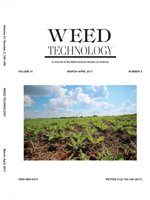Common ragweed is an important broadleaf weed in agronomic crops in the northcentral United States. A common ragweed biotype in glyphosate-resistant (GR) soybean production field in southeast Nebraska was not controlled after sequential applications of glyphosate at the labeled rate. The objectives of this study were to confirm GR common ragweed in Nebraska by quantifying the level of resistance in greenhouse and field whole-plant dose-response studies and to evaluate the response of the putative GR common ragweed to POST corn and soybean herbicides. Greenhouse wholeplant dose-response studies confirmed 7- and 19-fold resistance to glyphosate compared to the known glyphosate-susceptible (GS) biotype based on biomass reduction and control estimates, respectively. Field dose-response studies conducted in 2015 and 2016 at the putative GR common ragweed research site suggested that glyphosate doses equivalent to 15- and 40-times the labeled rate (1,260 g ae ha-1) were required for 90% control and biomass reduction, respectively. Response of GR common ragweed to POST soybean herbicides in greenhouse studies indicated ≥89% control with acifluorfen, fomesafen, fomesafen plus glyphosate, glyphosate plus dicamba or 2,4-D choline, glufosinate, imazamox plus acifluorfen, and lactofen. POST corn herbicides, including 2,4-D, bromoxynil, diflufenzopyr plus dicamba, glufosinate, halosulfuron-methyl plus dicamba, mesotrione plus atrazine, and tembotrione provided ≥87% control, indicating that POST herbicides with distinct modes of action are available in corn and soybean for effective control of GR common ragweed. Results also suggested a reduced efficacy of the acetolactate synthase (ALS)-inhibiting herbicides tested in this study for control of GR and GS biotypes, indicating further research is needed to determine whether this biotype has evolved multiple herbicide resistance.
Nomenclature: 2,4-D; acifluorfen; atrazine; bentazon; bromoxynil; carfentrazone; chlorimuron; dicamba; fluthiacet; fomesafen; glufosinate; glyphosate; halosulfuron; imazethapyr; imazamox lactofen; mesotrione; primisulfuron; tembotrione; thifensulfuron; topramezone; common ragweed, Ambrosia artemisiifolia L.; corn, Zea mays L.; soybean, Glycine max (L.) Merr





